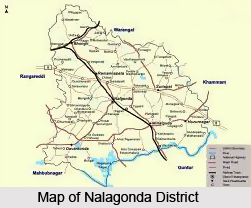 Geography of Nalgonda District in Telangana covers with the variant landforms and pleasant landforms. Nalgonda district is situated in the State of Telangana, between 16-25 degree and 17-50 degree of the Northern Latitude and 78-40 degree and 80-05 degree of Eastern longitude covering an area of 14,240 Sq. Kilometres.
Geography of Nalgonda District in Telangana covers with the variant landforms and pleasant landforms. Nalgonda district is situated in the State of Telangana, between 16-25 degree and 17-50 degree of the Northern Latitude and 78-40 degree and 80-05 degree of Eastern longitude covering an area of 14,240 Sq. Kilometres.
Extension of Nalgonda District
Nalgonda District is located in the Southern part of the Telengana region, Nalgonda district became part of Telangana with effect from 2014 that is after reorganization of Telangana after bifurcated from Andhra Pradesh. It was formerly known as "Nilgiri"
Nalgonda District is bounded by the Medak district and Warangal district in the North, Guntur district and Mahbubnagar district in the South, Khammam district and Krishna district in the East and Mahabubnagar district and Ranga Reddy district in the West.
Climate of Nalgonda District
The geographical area of Nalgonda District is 14,217 Sq. Kilometres. The region experiences a hot and dry summer throughout the year except during the South West Monsoon season. The year may broadly be divided into four seasons. It experiences cold season from December to Mid February, summer season from Mid February to first week of June. South West monsoon season from June to September and retreating monsoon or the past monsoon season during October to November. Cold season, extending from December to February, is followed by summer when both day and night temperatures increase sharply. May being the hottest month, the mean daily maximum temperature is about 40 degree Celsius and the mean daily minimum is about 28 degree Celsius sometimes the day temperature crosses 44 degree Celsius during this period. On some days, afternoon thundershowers come as a blessing and though temporarily they bring relief from the oppressive summer heat. By about the beginning of October day temperature decreases steadily signalling the withdrawal of monsoon. The day and night temperature decrease rapidly during November. December is the coldest month with the mean daily maximum and minimum temperatures being 35 degree C and 20 degree C respectively. Sometimes during the cold season, night temperature may drop down to about 10 degree C. The skies are generally clear or lightly clouded throughout the year except during south west monsoon season when heavy clouds cast the skies.
Annual Rainfall of Nalgonda District
The average rainfall in the district is 772 mm. 71% of the annual rainfall is received by the district during south west monsoon (i.e. June to September). September is the rainiest month. During summer and retreating monsoon season some amount of rainfall is received in the form of thunder showers. The variation in the annual rainfall in the district from year to year is large. On an average there are 46 rainy days. (i.e. days with rainfall of over 2.5mm or more).
Soils of Nalgonda District
The soils of the district are mainly `red earth`s` comprising loamy sands, sandy loams and sandy clay loams. In the areas of flat topography and along side the Krishna River and its tributaries, regur or black cotton soil is found.
Agriculture of Nalgonda District
The increased Irrigation facilities have given a boost to agricultural activity in the district. Out of a total of 14, 23,423 hectares of land utilisation in the district, more than 50% is cultivable land. The terrain of the district is very suitable for irrigation development. The government has taken all measures to increase the percentage of land under cultivation by expending irrigation facilities. The emphasis was not only on major irrigation projects but area specific and need specific minor and lift irrigation projects were also given predominant importance. The main crops grown in the district are Paddy, Jowar, Bajra, Ground Nut, Red gram, Green gram, Castor and Sugarcane is being grown in command areas to the extent of about 1,50,000 acres. The practice of mixed cropping is limited to dry crops. Jowar is grown mixed with red grams or bajra. Red gram is also grown mixed with groundnut or bajra or green gram.



















